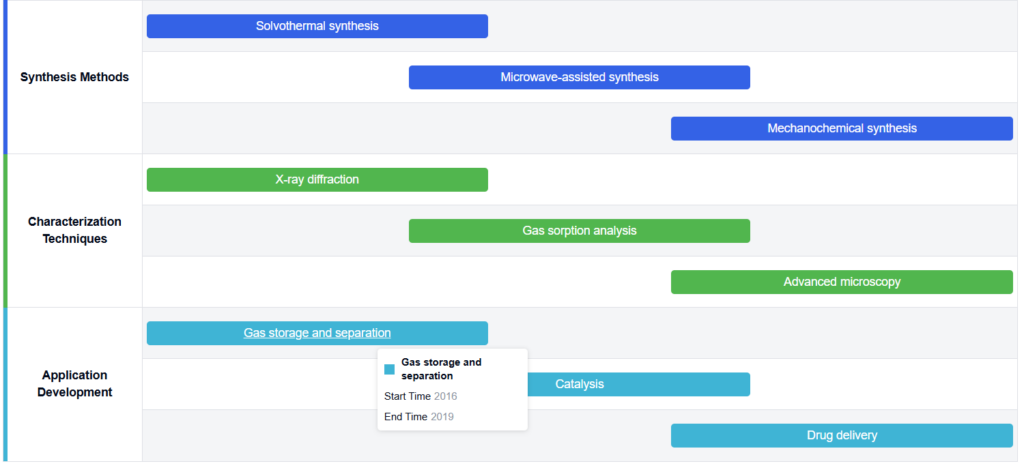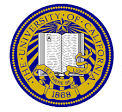
MOF Evolution and Objectives
Metal-Organic Frameworks (MOFs) have revolutionized porous materials research over the past two decades. Scientists first introduced permanent porosity in coordination polymers during the late 1990s. This discovery sparked rapid growth in the field, supported by new synthesis techniques and advanced characterization tools. Initially, researchers focused on building novel structures and studying their basic properties. These efforts helped clarify the relationship between MOF composition, structure, and function.
Exploring the future of MOFs? Eureka Technical Q&A helps you stay ahead with expert insights into metal–organic framework innovations, market trends, and emerging applications—empowering smarter decisions in materials science and industry.
Over time, the research emphasis shifted toward tailoring MOFs for real-world applications. This shift led to the creation of more advanced, use-specific materials. Today, MOF research targets critical issues in energy, the environment, and healthcare. Scientists aim to improve MOF stability and scale-up production without increasing costs. They design MOFs to withstand industrial conditions and maintain performance under stress.

In addition, researchers fine-tune pore structures and surface chemistry to enhance application-specific efficiency. MOFs now show promise in gas storage, chemical separation, catalysis, and drug delivery. Moreover, teams are developing greener synthesis methods and using renewable materials to meet sustainability goals.
Looking ahead, MOFs are set to play a major role in future technologies. Experts anticipate breakthroughs in energy storage, carbon capture, water purification, and medicine. Interdisciplinary teams will likely drive these advancements, bridging lab research and industrial deployment. As the field matures, MOFs will help solve global challenges with precision and innovation.

MOF Market Demand Analysis
The market demand for Metal-Organic Frameworks (MOFs) has been steadily increasing in recent years, driven by their unique properties and diverse applications across various industries. Market analysts project the global MOF market to grow at a CAGR of 13.5% from 2021 to 2028, reaching $1.2 billion. This growth primarily reflects rising demand for MOFs in gas storage, separation, catalysis, sensing, and drug delivery applications.
In the energy sector, MOFs are gaining traction for their potential in hydrogen storage and carbon capture technologies. Countries worldwide are actively reducing carbon emissions and shifting to cleaner energy sources, which increases the demand for MOFs in these applications. The automotive industry is also showing increased interest in MOFs for their use in fuel cells and gas storage systems, particularly in the development of hydrogen-powered vehicles.
The pharmaceutical and healthcare industries are emerging as significant consumers of MOFs, driven by their potential in drug delivery systems and medical imaging. The ability of MOFs to encapsulate and release drugs in a controlled manner has attracted considerable attention from pharmaceutical companies, leading to increased research and development activities in this area.
Environmental applications, such as water purification and air filtration, represent another growing market for MOFs. With increasing concerns about water scarcity and air pollution, there is a rising demand for advanced materials capable of efficiently removing contaminants from water and air. MOFs’ high surface area and tunable pore size make them ideal candidates for these applications.
Geographically, North America and Europe currently dominate the MOF market, owing to their advanced research infrastructure and strong presence of key players. Rapid industrialization, rising environmental concerns, and growing R&D investments are driving the fastest MOF market growth in the Asia-Pacific region.
Despite the positive outlook, challenges such as high production costs and scalability issues continue to hinder widespread adoption of MOFs in certain applications. However, ongoing research efforts aimed at developing more cost-effective synthesis methods and improving the stability of MOFs are expected to address these challenges and further drive market growth.
In conclusion, the market demand for MOFs is poised for significant growth across various industries, with energy, healthcare, and environmental applications leading the way. As research progresses and new applications emerge, the MOF market is likely to expand further, offering substantial opportunities for both established players and new entrants in the field.
MOF Development Status
Metal-Organic Frameworks (MOFs) have emerged as a promising class of materials with diverse applications across various industries. The current development status of MOFs reflects significant advancements in synthesis, characterization, and application over the past two decades. Researchers have successfully synthesized thousands of MOF structures, each with unique properties and potential uses. The field has witnessed a rapid expansion in both academic research and industrial development, with an increasing number of patents and commercial applications being realized.
In terms of synthesis, scientists have made substantial progress in developing new methods to create MOFs with enhanced properties and scalability. Traditional solvothermal synthesis has been complemented by innovative approaches such as mechanochemical, electrochemical, and microwave-assisted synthesis, enabling more efficient and environmentally friendly production processes. These advancements have led to the creation of MOFs with improved stability, porosity, and functionality, expanding their potential applications.

Characterization techniques for MOFs have also evolved significantly. Advanced analytical methods, including high-resolution electron microscopy, in-situ X-ray diffraction, and computational modeling, have provided deeper insights into MOF structures and properties. This enhanced understanding has facilitated the design of MOFs with tailored characteristics for specific applications.
The application landscape for MOFs has broadened considerably. Initially focused on gas storage and separation, MOFs are now being explored for use in catalysis, drug delivery, sensing, and energy storage. In the field of gas storage, MOFs have shown promise for hydrogen and methane storage, with some materials approaching or surpassing Department of Energy targets. For gas separation, MOFs have demonstrated high selectivity and efficiency in separating CO2 from flue gas and other gas mixtures.
In catalysis, MOFs are being investigated as heterogeneous catalysts for various chemical transformations, offering advantages such as high surface area, tunable pore size, and the ability to incorporate multiple catalytic sites. The biomedical field has seen growing interest in MOFs for drug delivery and imaging applications, leveraging their porosity and biocompatibility.
Despite these advancements, challenges remain in the large-scale production and commercialization of MOFs. Issues such as scalability, cost-effectiveness, and long-term stability under real-world conditions need to be addressed. However, ongoing research and development efforts are making steady progress in overcoming these obstacles, with several companies now offering commercial MOF products for specific applications.
MOF Technology Roadmap


Key MOF Industry Players
The metal-organic frameworks (MOFs) market is in a growth phase, with increasing research and commercial interest. The global MOF market is expected to expand significantly in the coming years, driven by applications in gas storage, catalysis, and drug delivery. Technologically, MOFs are advancing rapidly, with key players like the University of California, Northwestern University, and BASF SE leading innovation. Academic institutions such as South China University of Technology and The University of Chicago are contributing to fundamental research, while companies like ExxonMobil and China Petroleum & Chemical Corp. are exploring industrial applications. The technology’s maturity varies across sectors, with some applications nearing commercialization while others remain in early development stages.
 The Regents of the University of California
The Regents of the University of California
Technical Solution
The University of California has developed a series of novel Metal-Organic Frameworks (MOFs) with exceptional porosity and surface area. Their approach focuses on creating MOFs with tunable pore sizes and functionalities, allowing for precise control over gas adsorption and separation properties. They have successfully synthesized MOFs with record-breaking surface areas exceeding 7,000 m²/g, utilizing advanced ligand design and post-synthetic modification techniques. These MOFs demonstrate remarkable performance in applications such as carbon capture, hydrogen storage, and catalysis.
Strengths: Cutting-edge research in MOF design, high-performance materials with record-breaking properties.
Weaknesses: Potential scalability issues for industrial applications, high production costs for complex MOF structures.
 Northwestern University
Northwestern University
Technical Solution
Northwestern University has established itself as a leader in Metal-Organic Framework (MOF) research, particularly in the development of MOFs for sensing and catalysis applications. Their approach focuses on creating MOFs with precise control over pore environment and functionality. Northwestern researchers have pioneered the use of MOFs as platforms for single-site catalysts, enabling highly selective and efficient chemical transformations. They have also developed MOFs with unique optical and electronic properties for use in chemical sensing and light-harvesting applications. Their work extends to the integration of MOFs into devices and the exploration of MOF-based materials for biomedical applications.
Strengths: Cutting-edge research in MOF-based catalysis and sensing, strong focus on fundamental understanding of MOF properties.
Weaknesses: Some applications may be far from commercial readiness, potential challenges in scaling up complex MOF systems.
 BASF SE
BASF SE
Technical Solution
BASF SE has developed a commercial-scale production process for Metal-Organic Frameworks (MOFs) under the brand name Basolite®. Their technology focuses on scalable synthesis methods and the development of MOFs for specific industrial applications. BASF has successfully commercialized MOFs for use in various sectors, including gas storage, separation processes, and heat transformation. Their approach combines innovative MOF designs with practical considerations for large-scale manufacturing, ensuring consistent quality and performance. BASF’s MOFs are particularly noted for their stability and durability under industrial conditions.
Strengths: Established commercial production capabilities, wide range of industrial applications. Weaknesses: Limited to specific MOF types suitable for mass production, potential challenges in adapting to rapidly evolving MOF research.
 King Abdullah University of Science & Technology
King Abdullah University of Science & Technology
Technical Solution
King Abdullah University of Science & Technology (KAUST) has developed a comprehensive research program on Metal-Organic Frameworks (MOFs) with a focus on energy and environmental applications. Their approach combines advanced computational modeling with innovative synthesis techniques to create MOFs with tailored properties. KAUST researchers have successfully developed MOFs for water harvesting in arid climates, efficient carbon capture, and energy storage applications. They have also pioneered the use of MOFs in membrane technologies for gas separation and water purification.
Strengths: Interdisciplinary approach combining computational and experimental methods, focus on addressing regional environmental challenges.
Weaknesses: Potential limitations in scaling up laboratory discoveries to industrial applications.
 China Petroleum & Chemical Corp.
China Petroleum & Chemical Corp.
Technical Solution
China Petroleum & Chemical Corp. (Sinopec) has developed a range of Metal-Organic Frameworks (MOFs) tailored for applications in the oil and gas industry. Their research focuses on MOFs with high stability in harsh environments, particularly for use in gas separation and purification processes. Sinopec has successfully synthesized MOFs capable of efficiently separating CO2 from natural gas streams, as well as MOFs for the removal of sulfur compounds from petroleum products. Their approach combines computational screening methods with experimental validation to accelerate the discovery of industrially relevant MOF materials.
Strengths: Strong focus on practical applications in the oil and gas sector, robust MOFs suitable for industrial conditions.
Weaknesses: Potentially limited scope of MOF applications outside the petroleum industry.
Current MOF Solutions
Market analysis and forecastingThe Metal-Organic Frameworks (MOF) market is experiencing significant growth, with various analytical tools and forecasting methods being employed to predict market trends. These include data-driven approaches, machine learning algorithms, and statistical models to assess market potential, identify growth opportunities, and forecast future demand for MOF-based products and applications.
- Market analysis and forecasting techniques for Metal-Organic Frameworks
Various methods and systems are employed for analyzing and forecasting market trends in the Metal-Organic Frameworks (MOFs) industry. These techniques may include data mining, statistical analysis, and machine learning algorithms to predict market behavior, identify growth opportunities, and assess competitive landscapes. Such analyses help businesses make informed decisions regarding product development, investment strategies, and market positioning in the rapidly evolving MOFs sector. - Technological advancements and applications driving MOF market trends
The Metal-Organic Frameworks market is influenced by ongoing technological advancements and expanding applications across various industries. Key trends include the development of novel MOF structures with enhanced properties, integration of MOFs in energy storage and gas separation technologies, and their potential use in drug delivery systems. These innovations are expected to drive market growth and create new opportunities for MOF manufacturers and end-users. - Environmental and sustainability factors impacting MOF market trends
Growing environmental concerns and the push for sustainable technologies are significantly influencing the Metal-Organic Frameworks market. Researchers and companies increasingly explore MOFs for carbon capture, water purification, and renewable energy applications. This trend drives investment in R&D and speeds up the commercialization of MOF-based products that tackle environmental challenges.
Technological advancements in MOF synthesis
Ongoing research and development efforts are focused on improving MOF synthesis techniques, enhancing their properties, and expanding their applications. This includes the development of novel precursors, optimization of reaction conditions, and exploration of new synthesis methods to create MOFs with tailored characteristics for specific industrial applications.Expand
Emerging applications and industry adoption
The MOF market is witnessing increased adoption across various industries, including gas storage and separation, catalysis, drug delivery, and environmental remediation. New applications are continually being explored, driving market growth and attracting investment in research and commercialization efforts.Expand
Sustainability and environmental considerations
There is a growing focus on developing sustainable MOFs and environmentally friendly synthesis methods. This trend is driven by increasing environmental awareness and regulatory pressures, leading to research into bio-based precursors, green synthesis techniques, and MOFs designed for environmental applications such as carbon capture and water purification.Expand
Commercialization and market strategies
As the MOF market matures, there is an increasing emphasis on commercialization strategies, intellectual property management, and market positioning. Companies are developing business models to capitalize on MOF technologies, forming partnerships, and exploring licensing opportunities to gain a competitive edge in this emerging market.
Core MOF Innovations




Future MOF Research Directions
Advanced MOF Synthesis Techniques
Metal-Organic Frameworks (MOFs) have revolutionized porous materials research over the past two decades. Scientists first introduced permanent porosity in coordination polymers during the late 1990s. This discovery sparked rapid growth in the field, supported by new synthesis techniques and advanced characterization tools. Initially, researchers focused on building novel structures and studying their basic properties. These efforts helped clarify the relationship between MOF composition, structure, and function.
Over time, the research emphasis shifted toward tailoring MOFs for real-world applications. This shift led to the creation of more advanced, use-specific materials. Today, MOF research targets critical issues in energy, the environment, and healthcare. Scientists aim to improve MOF stability and scale-up production without increasing costs. They design MOFs to withstand industrial conditions and maintain performance under stress.
In addition, researchers fine-tune pore structures and surface chemistry to enhance application-specific efficiency. MOFs now show promise in gas storage, chemical separation, catalysis, and drug delivery. Moreover, teams are developing greener synthesis methods and using renewable materials to meet sustainability goals.
Looking ahead, MOFs are set to play a major role in future technologies. Experts anticipate breakthroughs in energy storage, carbon capture, water purification, and medicine. Interdisciplinary teams will likely drive these advancements, bridging lab research and industrial deployment. As the field matures, MOFs will help solve global challenges with precision and innovation.
Multifunctional and Stimuli-Responsive MOFs
Multifunctional and stimuli-responsive MOFs mark a groundbreaking direction in modern materials science. These advanced frameworks can adapt their behavior based on external conditions or specific triggers. Researchers aim to develop “smart” MOFs that respond dynamically while performing multiple tasks within a single structure.
One major area of focus is combining sensing and actuating functions in a single MOF. These materials can detect specific molecules and trigger a reaction—such as changing pore size or releasing a trapped compound. Scientists are designing MOFs that respond to light, temperature, pH, or magnetic fields.
For example, light-sensitive MOFs could enable controlled drug delivery by releasing medications upon exposure to light. Temperature-responsive MOFs could manage heat by adjusting their gas absorption in response to temperature changes. Similarly, pH-sensitive variants could selectively capture or release ions in response to acidity shifts.
Another exciting development is the design of switchable MOFs. These materials can shift between states with distinct properties, such as magnetic, hydrophilic, or electronic behaviors. This versatility could lead to breakthroughs in catalysis, filtration, and flexible electronics.
Moreover, researchers are integrating multiple functions into a single MOF. These hybrid materials can perform tasks like sensing, catalysis, and selective adsorption simultaneously. This multifunctionality can create compact, high-efficiency systems for pollution control, energy storage, and chemical processing.
Some teams are also exploring MOFs as platforms for artificial molecular machines. These systems can mimic biological motion, using external signals to trigger internal mechanical shifts.
Strengths:
- Enable smart, adaptive material behavior
- Support multitasking functions in a single framework
- Expand potential for high-tech applications
- Enhance efficiency across environmental, medical, and industrial sectors
Weaknesses:
- Require complex design and synthesis
- May face durability or stability issues over time
- Demand advanced tools for precise characterization and testing
Environmental Impact of MOFs
Metal-Organic Frameworks (MOFs) continue to attract interest for their role in solving environmental challenges. These porous materials show impressive potential in carbon capture, water purification, and pollution control.
MOFs trap gases like CO₂ thanks to their large surface area and tunable pore structure. This makes them strong candidates for reducing greenhouse gas emissions. Researchers also use MOFs to remove harmful contaminants from water, helping to improve global water quality and availability.
However, MOFs also raise environmental concerns. The typical synthesis process involves organic solvents and metal salts, which can harm ecosystems if not handled carefully. Additionally, MOF production consumes energy and may generate chemical waste, raising questions about its overall sustainability.
To address these issues, scientists are developing greener synthesis methods. Many now use water-based or room-temperature reactions to reduce the use of toxic solvents. These improvements aim to lower energy use and reduce waste during production.
MOF durability in real-world conditions is another concern. Researchers must study how MOFs degrade over time to avoid releasing harmful byproducts into the environment. Understanding their breakdown and recyclability will help make MOFs safer and more sustainable.
Scalability remains a major challenge. While lab tests show great promise, transitioning MOFs to industrial-scale use requires cost-effective production and efficient supply chains. Engineers must also ensure that scaling up won’t create new environmental risks.
Despite these hurdles, MOFs still offer significant environmental benefits. Their ability to absorb pollutants and store gases could help reduce industrial emissions and support clean energy systems. As the field grows, the focus on eco-friendly production and end-of-life management will shape how MOFs impact sustainability efforts.
In summary, MOFs offer real environmental value, but responsible development is key. If researchers and manufacturers prioritize green practices, MOFs could become a powerful tool in building a cleaner, more sustainable world.
MOF Commercialization Challenges
Metal-Organic Frameworks (MOFs) offer immense potential, but several challenges still limit their commercial success.
High Production Costs
One major barrier is the high cost of MOF production. Complex synthesis methods and expensive raw materials raise manufacturing expenses. As a result, MOFs struggle to compete with cheaper, well-established alternatives in real-world applications.
Scalability Issues
Lab-scale methods often fail when scaled up for industrial use. Many processes lose efficiency, consistency, or yield at larger volumes. These challenges make it hard to mass-produce MOFs at a commercially viable price.
Environmental Stability
Another concern is poor stability in real-world conditions. MOFs may degrade when exposed to heat, moisture, or air pollutants. This limits their reliability in harsh industrial or outdoor settings.
Lack of Standardization
The MOF industry lacks unified standards for quality and performance. Without standard benchmarks, buyers struggle to compare products or ensure consistent results. This uncertainty slows down investment and adoption.
Regulatory Barriers
In sectors like healthcare and environmental cleanup, strict regulations can delay MOF deployment. Most frameworks weren’t designed with MOFs in mind, leading to lengthy approval processes.
Intellectual Property Complexity
The patent landscape around MOFs is highly fragmented. Overlapping claims make licensing complex and risky for startups and manufacturers. Companies may hesitate to invest without legal clarity.
Market Awareness
Many potential users still don’t know what MOFs are or how they help. This lack of awareness limits interest and adoption. Companies must educate users and showcase practical benefits in clear, real-world terms.
Moving Forward
Overcoming these issues requires collaboration across industries, academia, and regulators. Standardizing production, improving scalability, and educating end-users will help unlock the full potential of MOFs. As these challenges are addressed, MOFs are poised to transform industries ranging from energy storage to environmental protection.
To get detailed scientific explanations of Metal–Organic Frameworks, try Patsnap Eureka.


